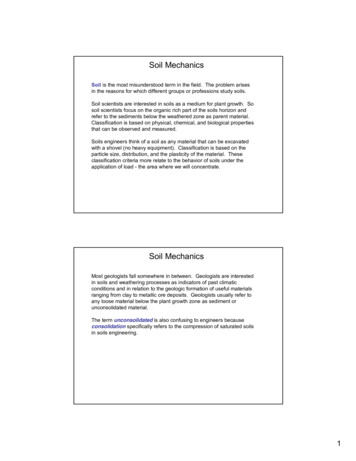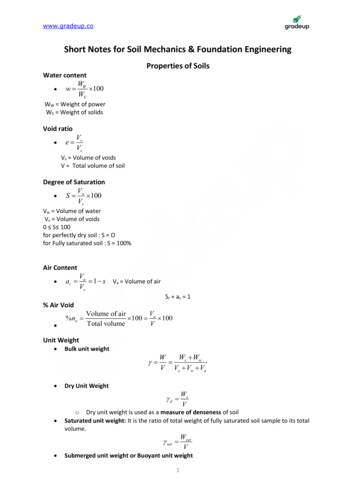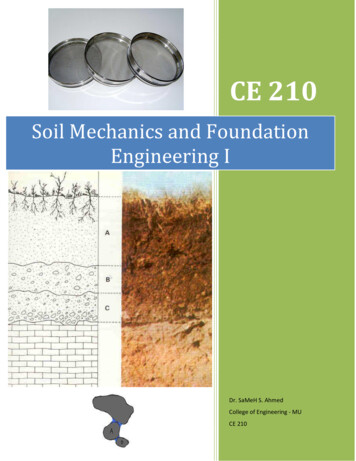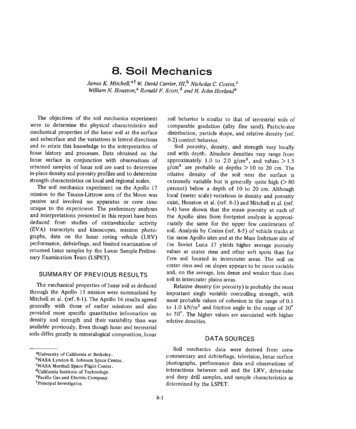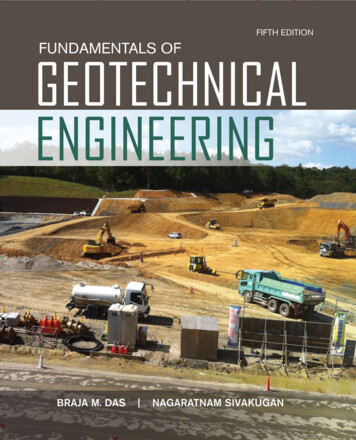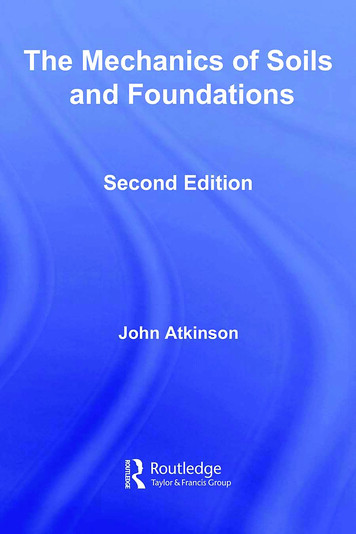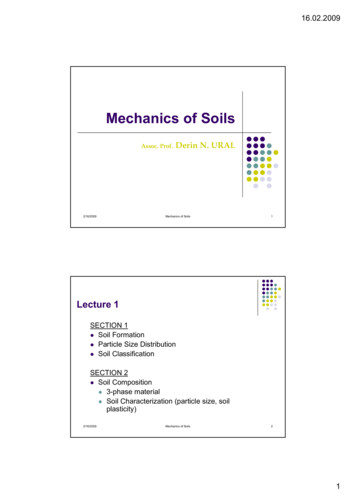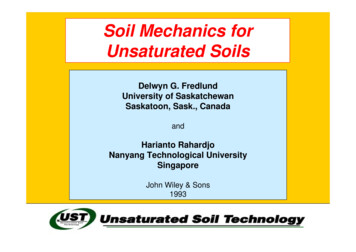
Transcription
Soil Mechanics forUnsaturated SoilsDelwyn G. FredlundUniversity of SaskatchewanSaskatoon, Sask., CanadaandHarianto RahardjoNanyang Technological UniversitySingaporeJohn Wiley & Sons1993Notes by: Jose Pereira,University of Brasilia, Brazil
PubWil lishedey& S by Joonshn, 1993
Soil Mechanics for Unsaturated SoilsTABLE OF CONTENTSChapter1Introduction to Unsaturated Soil Mechanics2Phase Properties and Relations3Stress State Variables4Measurement of Soil Suction5Flow Laws6Measurement of PermeabilityEstimations of --7Steady State Flow8Pore Pressure Parameters9Shear Strength Theory10Measurement of Shear Strength Parameters Estimations of --11Plastic and Limit Equilibrium12Volume Change Theory13Measurement of Volume Change Indices Estimations of --14Volume Change Predictions15One-dimensional Consolidation and Swelling16Two- and Three-dimensional Unsteady-state Flowand Non-isothermal Analyses
Notes at the bottom of each PowerPoint Slide Notes: Different approaches could be taken towards synthesizing thematerial on the behavior of unsaturated soil mechanics. Theapproach deemed most desirable was to maintain a relativelyclose parallel to classical saturated soil mechanics. The emphasis was not focused solely on “problematic soils”, butrather on the areas of seepage, shear strength and volumechange of all soils with negative pore-water pressures. The prepared notes closely follow the material in the textbook.Additional notes have been prepared on new and importantsubjects that have emerged during the years subsequent to 1993. The textbook appears to have filled an important role incentralizing our understanding of the behavior of unsaturated soilsfrom the standpoint of two independent stress state variables. Additional notes:
Format For Each Constitutive Behavior Constitutive Relationship (e.g., seepage,shear strength, volume change)– Theory associated with the ConstitutiveRelationship– Measurement of the associated unsaturatedsoil properties– Estimation of the unsaturated soil propertyfunctions (through use of SWCC)– Application of the constitutive relationshipto practical engineering problems
Important Objective of This Course To teach Geotechnical Engineers tothink the way the Unsaturated Soilbehaves The Physics must be correct Many behavioral aspects related toUnsaturated Soils are the opposite tosaturated soil behavior (e.g., hydraulicconductivity of sands capillarybarriers)
Categorization of Soil Mechanics
CATEGORIES OF UNSATURATEDSOIL MECHANICS PROBLEMSBased on Constitutive Behaviour
CLIMATIC CHARACTERISTICSMoisture fluxis an aspectoriginallyomitted fromSoil MechanicsCoupled masstransport & thermalanalysis
CAPILLARY FLOW PHENOMENAWater Table
EXAMPLES OF PROBLEMS REQUIRING AN UNDERSTANDING OF UNSATURATED SOIL MECHANICSCompactedSoilsInfiltrationand Rapid Drawdown
Bernatzik, 1948ProblematicSoils
ENVIRONMENTAL EFFECTS DURING THEOPERATION OF THE RESERVOIRWater phaseSOME RELEVANT QUESTIONS MIGHT BE ASKED ASSTEADY STATE CONDITIONS ARE ESTABLISHED?
STABILITY OF VERTICAL ORNEAR VERTICAL EXCAVATIONSCover of some type?SOME RELEVANT QUESTIONS THAT MIGHT BE ASKED AREREFERRED TO THE STABILITY OF THE EXCAVATION SLOPES
LATERAL EARTH PRESSURESEffect of amembrane?SOME RELEVANT QUESTIONS MIGHT BE ASKEDPERTAINING TO LATERAL EARTH PRESSURES?
LATERAL EARTH PRESSURESAGAINST WALLS?
IS THERE A NEED FORUNSATURATED SOIL MECHANICS?YES!The Geotechnical Engineer has the greatest potential to assistthe public in circumventing problems associated withUnsaturated SoilsConcern for the environment and advances in computing powergreatly assisted in the promotion of Unsaturated Soil Mechanics
AN UNSATURATED SOIL ELEMENT WITHA CONTINUOUS AIR PHASE
TERMINOLOGY AND DEFINITIONS
Categorization of Soil MechanicsBased on Stress State VariablesVisualizationof the Worldof SaturatedUnsaturatedSoilMechanicsNegative pore-waterpressuresMatric suctionNet normal stress(ua - uw)(σ - ua)(σ - uw)Effective stressSaPositive pore-waterpressurestu rated S oil M echscian
Stress Stateat a Point in anUnsaturated Soiland in aSaturated Soil(σy - ua)(ua - uw)τyzτyxτxz(ua - uw)(σx - ua)τzxτxτzyd Soil MechuratetanasicsnUiturated Soil Me c ha ny(σz - ua)(σy - uw)τyzτyxSa(ua - uw)τxzcs(σx - uw)τzxτxyτzy(σz - uw)
Summary of thedescription of theStress State for anUnsaturated SoilElement with thePreferred StressState Variables
Stress State Variables (Unsaturated Soils)Net Total Stress Tensor StressTensors formthe basis fora Sciencebecause welive in a 3-DCartesiancoordinateworld (σx ua ) τ xy τ xz (ua uw) 0 0τ yx(σy ua )τzx τzy (σz ua ) τ yz00 (ua uw)0 (ua uw) 0Matric Suction Stress Tensor
Variations in Stress State Descriptionσ’ (σ – ua) χ (ua – uw)σ’ effective stressχ parameter related to saturationσ *ij σij – [S uw (1 – S) ua ] δ ijσij total stress tensor,δij Kroneker delta or substitution tensor,σ *ij Bishop’s soil skeleton stress (Jommi2000)S degreeof saturationAbove proposedequationsare constitutive relations
Separation of the Zones above the Water TableUnsaturated SoilDry soilTwofluid phasesCapillary fringeLegend- Solids- Water- AirOccluded air bubblesSaturated Soil
Constitutive Relations for ClassicProblems in Unsaturated SoilsMechanics Empirical, semi-empirical and theoreticalrelationships are proposed and verified– Volume change (Stress versus Strain)– Shear strength (Stress versus Stress)– Flow (Velocity versus Stress) Demanding laboratory experiments- Careful experiments required for uniquenessstudies- May alter test procedures for economic reasons
Constitutive Relations forSaturated/Unsaturated Soil MechanicsFundamentals of SoilMechanics in One DiagramSeepage h / yvv kkw(-u(- uw)w)dh/dyShearstrengthUnsaturatedτ c’ ( σ - u ) tan φ ’Soilτ c’ (σnn – uaa) tan φ’( ua –-uwu) wtan) tan (uφ bφabτ τ c’c’ ( (σσn – -uwu) tan) tanφ’ φ ’nwVolumechangeσ –- uua) ) ( σde de a a1 1dd(aa 2 ad(– uuaw)- u w )a2 d(uSaturatedSoil h / yvv kkww dh/dywhere: h uw/γw Yσ u- u) w )dede aa vd(dσ( –vw
Selected Reading Materials Fredlund, D.G. (2000). “The 1999 R.M. Hardy Lecture: TheImplementation of Unsaturated Soil Mechanics intoGeotechnical Engineering”, Canadian Geotechnical Journal,37 (5), 963-986 Fredlund, D.G. (2002). “Use of the Soil-Water CharacteristicCurve in the Implementation of Unsaturated Soil Mechanics”,Keynote Address, March 10-13,UNSAT 2002, Recife, Brazil,Vol. 3. Ha, T.V. Pham, and Fredlund, D. G. (2002). “The Application ofDynamic Programming to Slope Stability Analysis”, CanadianGeotechnical Journal, pp. 830-847. Gitirana, Gilson, and Fredlund, D. G., (2003). “FromExperimental Evidence Towards the Assessment of WeatherRelated Railway Embankment Hazards" Proc. Of the Conf. on“From Experimental Evidence Towards Numerical Modelling ofUnsaturated Soils”, Sept. 18-19.
Review of Procedure Typical to Saturated Soil Mechanics1.) Define geometry of the problem (Surface& Sratigraphy)2.) Determine pore-water pressures3.) Determine the soil parameters (c’ & φ’)4.) Use analysis to incorporate total stressesPore-water pressuresmust be assessedbecause behavior iscontrolled by (σ – uw)
Additional Features to AccommodateRainfall Induced Landslides Slope must be visualized as a transient analysis ona saturated-unsaturated soil profile Unsaturated soil has water storage capabilities Unsaturated soil has highly varying coefficient ofpermeability and infiltration conditions Shear strength of the unsaturated soil must betaken into account Actual (or real-time) flux moisture conditions (i.e.,rainfall) must be taken into account Calculation of factor of safety must account forunsaturated soil behavior
Analysis Can Be Viewed as a Combinationof the Following Elements of Physics Saturated-unsaturated seepageanalysis (Permeability and Storage) Stress analysis for the shear andnormal forces (Method of Slices or StressAnalysis) Shear strength evaluation of theunsaturated soil (angle φb ) Evaluation of surface moisture fluxconditions (Percentage of ksat) Calculation of factor of safety, Fs
NATURAL SLOPES SUBJECTED TOENVIRONMENTAL CHANGESRELEVANT QUESTIONS?
Initial steady state conditions2080 mm/ year 6.6 x 10 -8 m/sQuite an extreme condition
230 kPa40 kPaInitial steady state conditionsalong Section X - X
Flux 1.3 x 10 -5 m/sAfter 120 minutes
After 480 minutesWhen the rain stopsFlux 0.0
After 1080 minutes
Heavy rainfall createsa wetting front
Loss of strengthRegain of strengthRain stops50% of φ’
Implementation of Unsaturated Soil Mechanics into Geotechnical Engineering”, Canadian Geotechnical Journal, 37 (5), 963-986 Fredlund, D.G. (2002). “Use of the Soil-Water Characteristic Curve in the Implementation of Unsaturated Soil Mechanics”, Keynote


